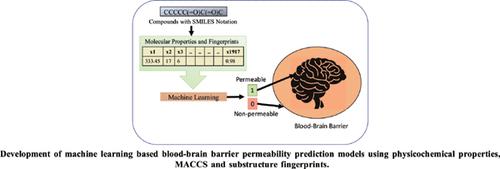Current Bioinformatics ( IF 2.4 ) Pub Date : 2021-06-30 , DOI: 10.2174/1574893616666210203104013 Deeksha Saxena 1 , Anju Sharma 2 , Mohammed Haris Siddiqui 3 , Rajnish Kumar 1

|
Background: Blood-Brain Barrier (BBB) protects the central nervous system from systemic circulation and maintains the homeostasis of the brain. BBB permeability is one of the essential characteristics of drugs acting on the central nervous system to indicate if the drug could reach the brain or not. The available laboratory methods for the prediction of BBB permeability are accurate but expensive and time-consuming. Therefore, many attempts have been made over the years to predict the BBB permeability of compounds using computational approaches. The accuracy of the prediction models with external dataset has always been an issue with the prediction models.
Objective: To develop a Machine learning-based BBB permeability prediction model using physicochemical properties and molecular fingerprints.
Methods: Support vector machine (SVM), k-nearest neighbor (kNN), Random forest (RF), and Naïve Bayes (NB) algorithms were applied on a large dataset of 1978 compounds using 1917 feature vectors containing physicochemical properties, MACCS fingerprints, and substructure fingerprints to predict the BBB permeability.
Results and Discussion: The comparative analysis of performance metrics of developed models suggested that SVM with the radial basis function kernel performed better than the kNN, RF, and NB algorithms. The BBB permeability prediction model's accuracy with the SVM was 96.77%. The prediction performance of the model developed in this study was found better than the existing machine learning-based BBB permeability prediction models.
Conclusion: The prediction model developed in this study could be useful for screening compounds based on their BBB permeability at the preliminary stages of drug design and development.
中文翻译:

使用物理化学特性、MACCS 和子结构指纹开发基于机器学习的血脑屏障渗透率预测模型
背景:血脑屏障 (BBB) 保护中枢神经系统免受系统循环的影响并维持大脑的稳态。BBB 通透性是作用于中枢神经系统的药物的基本特征之一,以表明药物是否可以到达大脑。用于预测 BBB 渗透率的可用实验室方法准确但昂贵且耗时。因此,多年来已经进行了许多尝试来使用计算方法预测化合物的 BBB 渗透性。具有外部数据集的预测模型的准确性一直是预测模型的一个问题。
目标:利用物理化学特性和分子指纹开发基于机器学习的 BBB 渗透率预测模型。
方法:支持向量机 (SVM)、k-最近邻 (kNN)、随机森林 (RF) 和朴素贝叶斯 (NB) 算法应用于 1978 种化合物的大型数据集,使用 1917 个包含物理化学特性、MACCS 指纹、和亚结构指纹以预测 BBB 渗透性。
结果与讨论:已开发模型的性能指标的比较分析表明,具有径向基函数核的 SVM 的性能优于 kNN、RF 和 NB 算法。BBB 渗透率预测模型与 SVM 的准确性为 96.77%。发现本研究中开发的模型的预测性能优于现有的基于机器学习的 BBB 渗透率预测模型。
结论:本研究中开发的预测模型可用于在药物设计和开发的初步阶段根据其 BBB 渗透性筛选化合物。











































 京公网安备 11010802027423号
京公网安备 11010802027423号